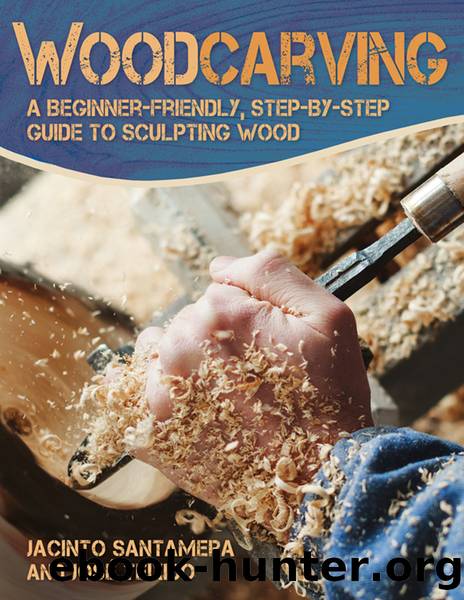Woodcarving by José Teixido

Author:José Teixido
Language: eng
Format: epub
ISBN: 9781510740433
Publisher: Skyhorse
Published: 2021-07-14T16:00:00+00:00
A modern woodcarver in Kenya. Thanks to their creativity and skill, he and his peers do without technical instruments.
Example of the Yosegi method: layout for the carving of Amida Nyorai.
The join of the forearm of an Egyptian wood-carving.
A Buddha that has lost an arm, revealing the hollow interior of the trunk.
Small Egyptian figure with articulated arms.
The most common method was using cloth or sacking soaked in plaster and glue.
Although these statues were then covered with more than fifteen layers of plaster and glue to form the basis for the polychrome, the wood finish was carried out with great care. Once the carving was finished, it was surfaced. This consisted of correcting small errors using paste and glue. Knots were either extracted directly or burned out. If this was not possible, the surface of the knot was roughened and rubbed with garlic to stop it from bleeding.
Below we include a couple of formulas for making the glues used in the surfacing process before the poly-chrome was added. The first belongs to Pacheco: âThe piece of mutton is placed in the water before being washed, then it is rinsed four or five times until the water runs clear, because cleanliness is important. . . . It should boil until thick and then be tested on the palms of the hands.â If the glue had to withstand a cold climate, he recommended adding parchment and ramâs or goatâs ears. He recommended removing the fat when it had cooled.
An even more exquisite recipe comes from Pomponio Gaurico (Florence, 1504). He suggested fish glue or âalso a mixture made from crushing limestone, mastic and cheese in identical measures.â
Tools that are no longer used but were important in rough-dressing and trimming or silhouetting were:
The iron wedge, which, when struck with a long-handled metal hammer, separated the fibers and split the trunk in half. Hard wooden wedges, struck with a mallet, were also used.
The ax was used for the initial rouging. Unlike the wedge, the ax could cut the fibers and could therefore be used in all directions. The were axes for all purposes. The hatchet was the easiest to handle. The length of the handle is in proportion to the weight of the ax blade.
The adz was the basic tool for rough-dressing. It was known as early as the Egyptians. The ones with a large handle were used with the trunk held between the feet. Short-handled adzes made precision cutting easier.
Download
This site does not store any files on its server. We only index and link to content provided by other sites. Please contact the content providers to delete copyright contents if any and email us, we'll remove relevant links or contents immediately.
On Writing A Memoir of the Craft by Stephen King(4847)
The Doodle Revolution by Sunni Brown(4667)
A Simplified Life by Emily Ley(4079)
Mummy Knew by Lisa James(3620)
Marijuana Grower's Handbook by Ed Rosenthal(3606)
Better Homes and Gardens New Cookbook by Better Homes & Gardens(3509)
Figure Drawing for Artists by Steve Huston(3360)
Paper Parties by Erin Hung(3354)
Draw Your Day by Samantha Dion Baker(3256)
The Genius of Japanese Carpentry by Azby Brown(3209)
Japanese Design by Patricia J. Graham(3097)
The Code Book by Simon Singh(3055)
Dangerous Girls by Haas Abigail(2955)
Lions and Lace by Meagan Mckinney(2911)
The Curated Closet by Anuschka Rees(2897)
How to Make Your Own Soap by Sally Hornsey(2812)
The Checklist Manifesto by Atul Gawande(2760)
The Wardrobe Wakeup by Lois Joy Johnson(2717)
Zero to Make by David Lang(2716)
